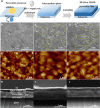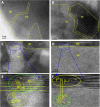Highly efficient and stable perovskite solar cells enabled by low-dimensional perovskitoids
- PMID: 35080965
- PMCID: PMC8791463
- DOI: 10.1126/sciadv.abk2722
Highly efficient and stable perovskite solar cells enabled by low-dimensional perovskitoids
Abstract
Deep traps originated from the defects formed at the surfaces and grain boundaries of the perovskite absorbers during their lattice assembly are the main reasons that cause nonradiative recombination and material degradation, which notably affect efficiency and stability of perovskite solar cells (PSCs). Here, we demonstrate the substantially improved PSC performance by capping the photoactive layer with low-dimensional (LD) perovskitoids. The undercoordinated Pb ions and metallic Pb at the surfaces of the three-dimensional (3D) perovskite are effectively passivated via the Pb-I bonding from the favorably lattice-matched 3D/LD interface. The good stability and hydrophobicity of the LD (0D and 1D) perovskitoids allow excellent protection of the 3D active layer under severe environmental conditions. The PSC exhibits a power conversion efficiency of 24.18%, reproduced in an accredited independent photovoltaic testing laboratory. The unencapsulated device maintains 90% of its initial efficiency after 800 hours of continuous illumination under maximum power point operating conditions.
Figures







References
-
- Jeon N. J., Noh J. H., Kim Y. C., Yang W. S., Ryu S., Seok S. I., Solvent engineering for high-performance inorganic–organic hybrid perovskite solar cells. Nat. Mater. 13, 897–903 (2014). - PubMed
-
- Lee M. M., Teuscher J., Miyasaka T., Murakami T. N., Snaith H. J., Efficient hybrid solar cells based on meso-superstructured organometal halide perovskites. Science 338, 643–647 (2012). - PubMed
-
- Stranks S. D., Eperon G. E., Grancini G., Menelaou C., Alcocer M. J. P., Leijtens T., Herz L. M., Petrozza A., Snaith H. J., Electron-hole diffusion lengths exceeding 1 micrometer in an organometal trihalide perovskite absorber. Science 342, 341–344 (2013). - PubMed
-
- Li X., Bi D., Yi C., Décoppet J.-D., Luo J., Zakeeruddin S. M., Hagfeldt A., Grätzel M., A vacuum flash-assisted solution process for high-efficiency large-area perovskite solar cells. Science 353, 58–62 (2016). - PubMed
-
- Tsai H., Asadpour R., Blancon J. C., Stoumpos C. C., Durand O., Strzalka J. W., Chen B., Verduzco R., Ajayan P. M., Tretiak S., Even J., Alam M. A., Kanatzidis M. G., Nie W., Mohite A. D., Light-induced lattice expansion leads to high-efficiency perovskite solar cells. Science 360, 67–70 (2018). - PubMed
LinkOut - more resources
Full Text Sources
Research Materials

